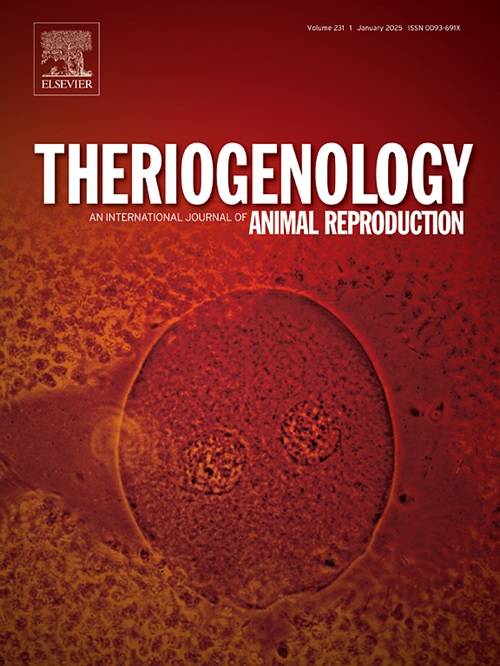腺内异体间充质干细胞注射治疗公牛慢性水泡性腺炎的疗效
IF 2.4
2区 农林科学
Q3 REPRODUCTIVE BIOLOGY
引用次数: 0
摘要
本研究旨在评价同种异体间充质干细胞(MSCs)在公牛精囊炎后囊泡腺的双侧和内源性应用的效果。在精液收集和处理中心选择了12头出现两次或两次以上复发的慢性膀胱炎的公牛,根据精液中脓的存在,运动和活力评估载玻片上的白细胞,对加州乳腺炎试验- CMT(一次交叉或多次)的反应,以及每个领域超过5个多形核细胞(PMN)的Diff快速染色载玻片上的白细胞的存在。超声检查水疱腺,临床症状是明确的诊断。建议的腺内注射MSCs的方法是用30-35厘米长的针和25-30厘米长的导管通过坐骨直肠窝直接注射到受影响的水疱腺。MSCs在Bio Cell Cellular Therapy®实验室(Brasilia, Brazil)培养并冷冻,通过洗涤和离心制备,用于应用当天的腺内注射。每个囊腺共注射3x106个MSCs。使用Shapiro-Wilk检验评估残差的正态性。当检验的正态性显著(P <;0.05),对数据进行转换或去除异常值并重新评估。使用“t检验”来识别治疗前后变量之间的统计学差异。P≤0.05为差异有统计学意义。数据以均数±标准误差(S.E.M.)表示。初始运动百分率从60.09±4.8提高到69.89±4.6 (P <;解冻后的运动百分率从26.26±6.77增加到42.5±5.99 (P <;0.05)。MSCs处理后产生的剂量数显著增加,从95.61±23.31个单位增加到337.84±67.75个单位(P <;0.05)每射精。每野观察到的白细胞数从5.83±0.48下降到零,表明炎症囊腺恢复。综上所述,3x106间充质干细胞应用于水疱炎公牛的水疱腺是安全有效的,因为它改善了本研究评估的几个参数,主要是每次射精产生的精液剂量。本文章由计算机程序翻译,如有差异,请以英文原文为准。
Effectiveness of intraglandular allogeneic mesenchymal stem cell administration for treating chronic vesicular adenitis in bulls
This study aimed to evaluate the effects of the application of allogeneic mesenchymal stem cells (MSCs) bilaterally and intraglandularly in the vesicular glands of bulls affected by seminal vesiculitis. Twelve bulls that presented chronic vesiculitis with two or more recurrences were selected at Semen Collection and Processing Centres, based on the presence of pus in the semen, leukocytes on the motility and vigour evaluation slide, reactive to the California Mastitis Test - CMT (one cross or more) and the presence of leukocytes on a slide stained by Diff Quik staining with more than 5 polymorphonuclear cells (PMN) per field. Ultrasound examination of the vesicular glands was performed, and the clinical signs were definitive for the diagnosis. The proposed method of the intraglandular injection of MSCs involved application through the ischiorectal fossa with a long needle measuring 30–35 cm and a guide measuring 25–30 cm in length directly into the affected vesicular glands. The MSCs were cultured and frozen in the Bio Cell Cellular Therapy® laboratory (Brasilia, Brazil) and prepared by washing and centrifugation for intraglandular injection on the day of application. In total, 3x106 MSCs were injected into each vesicular gland. Data were evaluated for normality of residuals using the Shapiro-Wilk test. When the normality of the test was significant (P < 0.05), the data were transformed or outliers were removed and reevaluated. The “T-Test” was applied to identify statistical differences between variables before and after treatment. The probability of P ≤ 0.05 was considered a significant difference. Data were presented as the mean ± standard error of the mean (S.E.M.). Improvements were observed in the initial percent motility from 60.09 ± 4.8 to 69.89 ± 4.6 (P < 0.05), as well as in the post-thawing percent motility from 26.26 ± 6.77 to 42.5 ± 5 0.99 (P < 0.05). The number of doses produced increased significantly after treatment with MSCs, from 95.61 ± 23.31 units to 337.84 ± 67.75 units (P < 0.05) per ejaculate. The number of leukocytes observed per field decreased from 5.83 ± 0.48 to zero, demonstrating the recovery of the inflamed vesicular glands. Based on the results presented, it was concluded that the application of 3x106 MSCs in the vesicular glands of bulls with vesiculitis is safe and efficient, as it improved several parameters evaluated in this research, mainly the production of semen doses per ejaculate.
求助全文
通过发布文献求助,成功后即可免费获取论文全文。
去求助
来源期刊

Theriogenology
农林科学-生殖生物学
CiteScore
5.50
自引率
14.30%
发文量
387
审稿时长
72 days
期刊介绍:
Theriogenology provides an international forum for researchers, clinicians, and industry professionals in animal reproductive biology. This acclaimed journal publishes articles on a wide range of topics in reproductive and developmental biology, of domestic mammal, avian, and aquatic species as well as wild species which are the object of veterinary care in research or conservation programs.
 求助内容:
求助内容: 应助结果提醒方式:
应助结果提醒方式:


